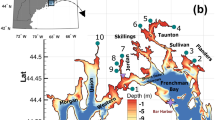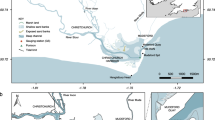Abstract
The northern Indian River Lagoon (IRL) has been experiencing severe water quality degradation and phytoplankton blooms in the last decade or so. Two important factors for maintaining high water quality in estuaries are the water residence time and connectivity. Here we used a newly developed high-resolution hydrodynamic model to investigate both factors in this area. Two types of numerical experiments have been carried out: (1) tracer dilution experiments in which an inert tracer was released from selected sub-basins and tracked for 3 months, and (2) particle experiments in which a number of neutrally buoyant particles were released from selected areas and tracked for 1 month. The results indicate that surface winds may drive complex yet coherent residual circulation, including semi-enclosed re-circulation cells, within each subbasin, with the patterns mainly depending on the directions of prevailing winds. These patterns may promote retention of waters and transport barriers within sub-basins, leading to long water residence time with limited connectivity between sub-basins, and spatial heterogeneity of water properties such as salinity, nutrients, organic matter, and dissolved oxygen. Despite their transient nature (weekly to monthly), these dynamic features and associated processes may also significantly affect the development of phytoplankton blooms and marine habitats in this region. On the other hand, water throughout the lagoon was strongly influenced by the water level in the coastal oceans, especially the frontal position of the Gulf Stream. This suggests that water exchanges through the inlets, albeit limited, are important to the water quality and phytoplankton blooms in the lagoon.












Similar content being viewed by others
Data Availability
All of the model results are archived at a HBOI server and available upon request. All of the third party data are also available upon request, either through the original web sites cited or from the author, subject to an agreement with the original data sources.
References
Adkins, M. et al. 2004. Watershed model development for the Indian River Lagoon basin: Providing simulated runoff and pollution load to the Indian River Lagoon Pollution load reduction model, SJRWMD, Technical memo 50, 71pp.
Bennett, J.R. 1974. On the dynamics of wind-driven lake currents. Journal of Physical Oceanography 4: 400–414.
Buskey, E.J., B. Wysor, and C. Hyatt. 1998. The role of hypersalinity in the persistence of the Texas “brown tide” in the Laguna Madre. Journal of Plankton Research 20: 1553–1565.
FLDEP. 2010. Basin management act plan for the implementation of total maximum daily loads for nutrients adopted by the Florida department of environmental protection in the Indian River Lagoon Basin Banana River Lagoon, Florida Department of Environmental Protection, 77pp.
García Charton, A., Pérez Ruzafa, and P. Sánchez Jerez. 1999. A landscape perspective for the study of the relationship between reef fish assemblages and habitat structure in S W Mediterranean. Il Naturalista Siciliano 23 (Suppl.): 169
Gobler, C.J., F. Koch, Y. Kang, D.L. Berry, Y.-Z. Tang, M. Lasi, J. Hall, J.D. Miller, and L. Walters. 2013. Expansion of harmful brown tides caused by the pelagophyte, Aureoumbra lagunensis DeYoe et Stockwell, to the US east coast. Harmful Algae 27: 29–41.
Hazen and Sawyer, P.C. 2008, Indian River Lagoon economic assessment and analysis update, IRLNEP report, 211pp.
Lapointe, B.E., L.W. Herren, D.D. Debortoli, and M.A. Vogel. 2015. Evidence of sewage-driven eutrophication and harmful algal blooms in Florida’s Indian River Lagoon. Harmful Algae, Harmful Algae 43: 82–102.
Levin, S.A. 1992. The problem of pattern and scale in ecology. Ecology 73: 1943–1967.
Lewis, D.M.K.A., T.C. MacDonald. Thompson, and G.S. Cook. 2021. Understanding shifts in estuarine fish communities following disturbances using an ensemble modeling framework. Ecological Indicators 126: 1872–7034. https://doi.org/10.1016/j.ecolind.2021.107623.
Mellor, G.L., and T. Yamada. 1982. Developement of a turbulence closure model for geophysical fluid problems. Reviews of Geophysics and Space Physics 20: 851–875.
Morris, L.J., L.M. Hall, J.D. Miller, M.A. Lasi, R.H. Chamberlain, R.W. Virnstein, et al. 2021. Diversity and distribution of seagrasses as related to salinity, temperature, and availability of light in the Indian River Lagoon. Florida Citizens for Science 84: 119–137.
Morris L.J., L.M. Hall, C.A. Jacoby, R.H. Chamberlain, M.D. Hanisak, J.D. Miller and R.W. Virnstein, 2022, Seagrass in a changing estuary, the Indian River Lagoon, Florida, United States. Frontiers in Marine Science 8:789818. https://doi.org/10.3389/fmars.2021.789818
Pawlowicz, R., B. Beardsley, and S. Lentz. 2002. Classical tidal harmonic analysis including error estimates in MATLAB using T_TIDE. Computers and Geosciences 28: 929–937.
Pinones, A., E.E. Hofmann, M.S. Dinniman, and J.M. Klinck. 2011. Lagrangian simulation of transport pathways and residence times along the western Antarctic Peninsula. Deep Sea Research Part II: Topical Studies in Oceanography 58: 1524–1539.
Phlips, E.J., et al. 2014. From red tides to green and brown tides: Bloom dynamics in a restricted subtropical lagoon under shifting climatic conditions. Estuaries and Coasts. https://doi.org/10.1007/s12237-014-9874-6.
Phlips, E. J., Badylak, S., Nelson, N. G., Hall, L. M., Jacoby, C. A., Lasi, M. A., et al. (2021). Cyclical patterns and a regime shift in the character of phytoplankton blooms in a restricted subtropical lagoon, Indian River Lagoon, Florida USA. Frontiers in Marine Science 8: 730934. https://doi.org/10.3389/fmars.2021.730934.
Robins, P.E., S.P. Neill, L. Gimenez, S.R. Jenkins, and S.K. Malham. 2013. Physical and biological controls on larval dispersal and connectivity in a highly energetic shelf sea. Limnology and Oceanography 58 (2): 505–524.
Saberi, A., and R.J. Weaver. 2016. Simulating tidal flushing response to the construction of a low-crested weir connecting Port Canaveral to the Banana River, Florida. Journal of Waterway, Port, Coastal, and Ocean Engineering 142 (4): 05016002.
Shchepetkin, A.F., and J.C. McWilliams. 2005. The Regional Ocean Modeling System: A split-explicit, free-surface, topography following coordinates ocean model. Ocean Modelling 9: 347–404.
Sheng, Y.P., and T. Kim. 2009. Skill assessment of an integrated modeling system for shallow coastal and estuarine ecosystems. Journal of Marine Systems 76: 212–243.
Smolarkiewicz, P.K., and L.G. Margolin. 1998. MPDATA: A finite-difference solver for geophysical flows. Journal of Computational Physics 140 (2): 459–480. https://doi.org/10.1006/jcph.1998.5901.
Smith, N.P. 1993. Tidal and nontidal flushing of Florida Indian River Lagoon. Estuaries 16: 739–746.
Steward J.S., and Van Arman J.A., 1987, Indian River Lagoon Joint Reconnaissance Report. Contract Report Nos. (CM-137 and CM-138). Florida Office of Coastal Management, Department of Environmental Regulation, 367p.
Sumner, D.M., and G. Belaneh. 2005. Evaporation, precipitation, and associated salinity changes at a humid, subtropical estuary. Estuaries 28 (6): 844–855.
Weaver, R.J., J.E. Johnson, and M. Ridler. 2016. Wind-driven circulation in a shallow microtidal estuary: The Indian River Lagoon. Journal of Coastal Research 32 (6): 1333–1343.
Weaver, R.J., P. Taeb, S. Lazarus, M. Splitt, B. P. Holman, and J. Colvin, 2016b, Sensitivity of modeled estuarine circulation to spatial and temporal resolution of input meteorological forcing of a cold frontal passage, Estuarine, Coastal and Shelf Science 183, 28e40.
Acknowledgements
This work is funded by Harbor Branch Oceanographic Institute Foundation via the Florida Center for Coastal and Human Health (FCCHH) and Florida Special License Plate Protect Wild Dolphin. All of the computation was completed at the Florida Atlantic University cluster KoKo. I thank SJRWMD for sharing their HSPF model output and FWRI and SFWDM for sharing their bathymetry data. I thank two anonymous reviewers for the review comments, which greatly improve the manuscript.
Author information
Authors and Affiliations
Corresponding author
Additional information
Communicated by David K. Ralston
Rights and permissions
Springer Nature or its licensor (e.g. a society or other partner) holds exclusive rights to this article under a publishing agreement with the author(s) or other rightsholder(s); author self-archiving of the accepted manuscript version of this article is solely governed by the terms of such publishing agreement and applicable law.
About this article
Cite this article
Jiang, M. Modeling Water Residence Time and Connectivity in the Northern Indian River Lagoon. Estuaries and Coasts 46, 1170–1189 (2023). https://doi.org/10.1007/s12237-023-01199-6
Received:
Revised:
Accepted:
Published:
Issue Date:
DOI: https://doi.org/10.1007/s12237-023-01199-6




